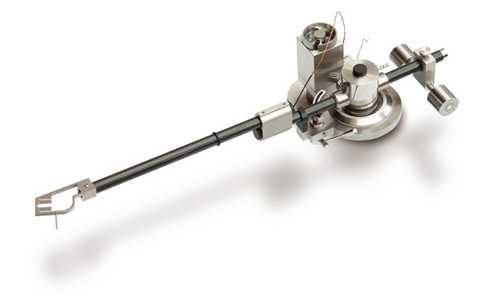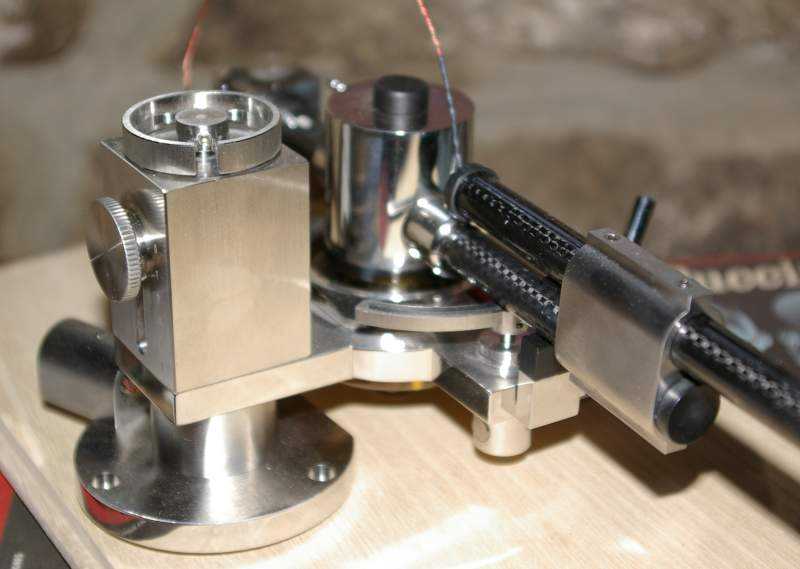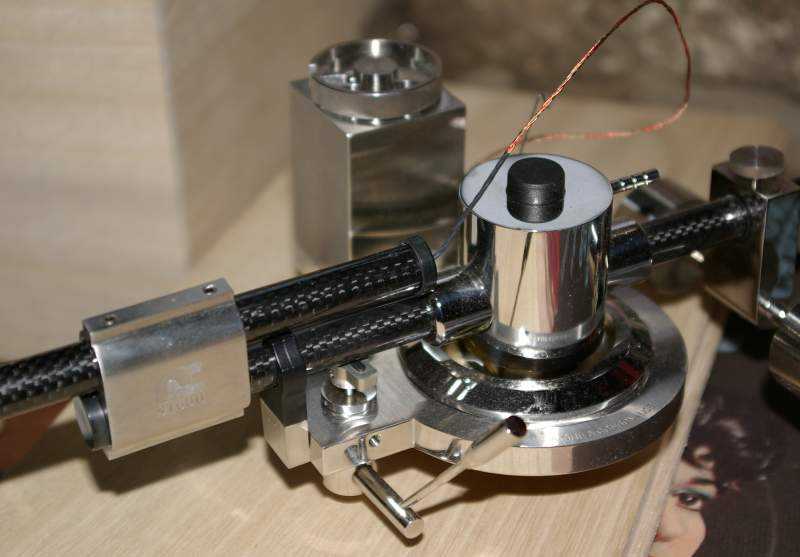
Product: Opera Audio ST600 tonearm
Manufacturer: Opera Audio - Made in China
Cost, approx: 2200 Euros, 1200 Euro if in combination with an Opera Turntable
Reviewer: Geoff Husband - TNT France
Reviewed: October 2007

Generally writing glib little introductory pieces for reviews sees me waffling about the subject in general in the hope it'll 'hook' you into reading the rest. In this case I don't know how to start - a short piece on the significance of the first ever Chinese arm with Hi-End pretensions? The idea of a new arm with on-the-fly, micrometric VTA adjustment? The price? The fact that for the first time ever we have an arm which is designed to work as both a 10.5" arm and a 12" arm? The originality of the thing? To be honest the thing is interesting in so many ways I felt it hard to 'slant' the review to any one point, so enough of the evasion and on with the show...
As you've read in the intro the arm is unusual in several ways and so I'll try to go through its features one-by-one. But before I do this I'd like to make clear that if this arm came from a top USA manufacturer and cost 2 twice as much as it does, the fit and finish would not surprise you. Costing 2200 Euro and coming from China it does - though from past experience with products from Opera that surprise is muted in my case. This price is good, but if bought with an Opera turntable it falls to 1200 Euro which is quite a different matter!
The first thing that strikes you,is the provision of a proper VTA tower for the micrometric adjustment of VTA. In design it apes the one supplied with the Triplanar, and shares with that design both it's advantages and disadvantages - it's smooth, and allows repeatable on-the-fly VTA adjustment whilst the record is playing. Certainly in look and feel it matches the Triplanar offering in most respects. It also shares the added complication and compromised rigidity of that design, unfortunately an inevitable consequence of such a structure.

The arm is a unipivot, and a very heavily damped one at that. The base of the arm-top sits in a bath of silicone gloop and rounded 'paddles' dip into this to damp rotational as well as vertical movement. There are a lot of arguments around damping unipivots, but most modern ones are damped and in this case it's beautifully executed.
This low-slung bearing housing, sitting in gloop, gives the arm a low Centre of Gravity, and the counterweight furthers this by hanging well below the counterweight stub. This consists of two outrigger weights, which will also stabilise the arm as it tries to rotate around its axis by increasing the rotational inertia. These weights can be slid back and forth to adjust azimuth and ensure that headshell, bearing housing and counterweight all line up vertically - something which with some arms using an offset counterweight can leave them looking a little drunken. This very low Centre-of-Gravity design is shared with many unipivots such as VPI, Kuzma, Morsiani etc. The alternative view championed by the likes of Graham and Audiomeca is that the C of G should be as close to the pivot as possible.
Counterweight stub and armtube stub, (more on this later) are in carbon fibre, woven in this case to give good torsional rigidity.
Most metal components are in polished stainless steel - making the arm very substantial and solid feeling. This extends to the headshell which uniquely in my experience, is CNC'd from a block of Stainless. This might seem madness as steel is about 3 times as heavy as aluminium, but it is also 3 times as stiff. In the past steel headshells were stamped from sheet and sort of a poor cousin to the aluminium castings, but the advantage of using steel in this application is that it can me machined into a skeletal structure which offers less area for vibrations to hit, and yet retains the rigidity of a similar mass aluminium shell - I like it...
But between this delightful headshell and all the gubbins at the bearing end resides the absolutely unique part for this arm - an exquisitely machined clamp that holds the stub arm to the main arm tube. The Triplaner uses something similar to offer azimuth adjustment, but in this case not only can the armtube be rotated after loosening two Allen bolts, but the armtube can be slid outwards to change the arm from a 10.5" to 12"!
There are two schools of thought on armtube length, but essentially both longer and shorter arms have advantages and disadvantages. A short arm will, all things being equal, be stiffer than the longer version. The use of carbon fibre, which is several times stiffer, weight-for-weight, than any metal negates this a little. It will also have a higher resonance frequency in the tube (good or bad?) as the tube is shorter. Lastly it will have a lower effective mass - generally, but not always desirable. Oh and it's also easier to fit on a turntable:-)
A longer arm will show better geometry than a short arm. All arms describe an arc across the record and the longer the radius of this arc (and thus the arm) the lower the angular error of the cartridge as it tracks the disc. This of course only applies if both arms tested are perfectly aligned.
So in the past you weigh these characteristics and settle for either the 12" or more usually 9" arm, the 10.5" being a sort of half-way-house compromise.
With the ST600 you buy the arm - then try both 10.5" and 12" to see which you prefer.

BUT of course changing the armtube length does change the characteristics of the arm in the ways described above. Pulling that tube to 12" not only improves the theoretical geometry, but also ups the effective mass of the arm considerably, as the heavy cartridge has to be racked away from the pivot, and then balanced by a similar movement of the counterweight. This is of course critical. The single most important thing when matching cartridge to arm is the matching of the compliance of the former to the effective mass of the latter. When pulled out to 12" the effective mass of the ST600, already high because of the very low Centre of Gravity and the clamp far away from the pivot, goes up to the level where the matching of cartridges may become difficult. Fitting the Dynavector DRT-1, a heavyweight at 14.5 grms, and a cartridge happy with arms to the high side of medium, I got a horizontal resonance of 6 Hz - very low indeed. The arm was so heavily damped in the vertical plane that I simply couldn't get a resonance plot. This combined with a very low Centre of Gravity* relative to the pivot ensures that tracking force will increase significantly as the arm rides over a warp. All this means that the cartridge cantilever has to soak up a lot of up/down movement whilst the arm stays still. A higher compliance cartridge like the Music Maker was a hopeless mismatch and tracking effected over warps.
Generally most modern arms fall in the medium-mass category and most cartridges are designed with this in mind, the ST600 bucks the trend and at 12" is a high-mass design that may upset some cartridges. Shortening the arm to 10.5" reduces this mass, but even here the arm is a medium-high design. The very heavy damping adds to the effect as it will resist sudden upwards movement of the cartridge (as in a 'ripple' in the vinyl) in much the same way as mass does.
This might read as a criticism of the design, but it isn't really. The arm is simply atypical and so it has to come with a health warning. There are cartridges which actually prefer higher mass arms, especially high-end moving coils like Koetsus and even vintage thoroughbreds like Ortofon SPU's - for such cartridges the choice of suitable arms is limited and the ST600 thankfully adds to the list. Just don't expect it to work with a typical MM (Moving Magnet) or high compliance MC.
Set-up was reasonably easy, helped by the VTA tower and plethora of adjustments available with the turn of an Allen key. The arm-base only needs three small holes (a la Linn) but without a centre hole as the arm does not extend below the armboard. Cabling is handled with a standard arm fitting from the back of the arm and an excellent quality cable is supplied. Anti-skate is a simple thread-and-weight and the cueing device smooth and easy to use. The low C of G and heavy damping make cueing as stable as most gimballed arms - all in all a very simple arm to use.
Now the crunch... And before I'm going to start I'm going to add a major caveat in that this arm is going to be very cartridge dependent and cartridges that are a good match are likely to be either expensive or possibly vintage... The DRT-1 matched OK but I'm not convinced it was the best match possible. The XX-2 I usually use as stock 'average' MC was sidelined by my wiping the cantilever off whilst mounting it while talking to someone at the same time. The Music Maker was a hopeless missmatch... However at the last minute Dynavector came to the rescue with their 17D3. This is a real oddball cart with a 1.5 mm long diamond cantilever. In theory it should have been a disaster but it seemed very happy on the ST600 and provided a tighter and more detailed view of the event, even than the DRT-1. Though not cheap it's definitely more 'real-world' than the DRT-1... At the Bargain Basement end of the scale the Denon 103 should be a good match. But in the end the DRT-1 gave the best overall sound so was used for the listening tests.
So all the following is based on using a very expensive cartridge only, but I hope it'll give at least a flavour of the beast.
It's not a high information design. Some arms, the Hadcock and Roksan Artemiz being classic examples, hunt out every detail and push it to the fore - the ST600 missed fine percussive details especially at the top end, quietly played ride cymbal in a complex mix being pushed back. The finest details of backing vocals could also be left behind in the mix. Likewise it didn't have the sheer heft of the SME V, Audiomeca Septum or EKOS. In some respects it reminded me of the Triplanar, perhaps it was the physical similarity fooling me (though the Triplanar is a gimballed arm), but there was the same ease of flow and musicality. It was very easy to lose yourself in the music rather than being on the edge of your seat, and of course this flattered certain forms of music more than others. It relished female vocal, from Arethra to Madonna, but if ever there was a 'smoky jazz' arm then this is it.
There's enough blood and guts in rock music or the more violent episodes in the Classical repertoire to remain credible, but it wouldn't be the first choice of someone who likes to come out of the listening room with their ears ringing.
Now I'm beginning to feel that at least some of this is down to autosuggestion, I'm discovering/imagining a commonality between arms that use carbon fibre armtubes. All I've heard seem to major on tone and flow, with a reduction of dynamics as the flip side. The trouble is that I've even thought up a pet theory for this - that the big mismatch in acoustic impedance between a metal headshell and the carbon tube means cartridge-produced vibrations are not taken away from the headshell; whilst vibrations coming from the turntable to the cartridge are likewise blocked - this is probably all b**locks but having a theory makes you begin to believe in it...
But the ST600 fits that prejudice for the moment.
Soundstaging is natural and unforced, with records that display it (e.g. Joe Jackson's Body and Soul) having fine depth. The soundstage also showed a fullness in height which was beguiling and allowed the image of real vocalists to form in front of you without the stretched-thin, sprayed-on soundstage some sources exhibit (did I mention CD?).
Tonal balance is on the warm side of neutral, the very top end a little rolled off and the mid-bass cosy and cosseting. Deep bass I though was a little shy, but then putting real deep-bass workouts on (the Gross Caisse at the start Of 'An American in Paris') showed it to be very deep if a little soft in character. But I guess the fact that I've spent an awful lot of time listening to vinyl since it's arrival is testament to the quality overall.
Surface noise levels are handled reasonably without reaching the suppression levels of the Communicator or the Dynavector 507. The better geometry showed itself with a very fine across-the-record performance, good enough to worry most 9" arms.
Looking at the design, build quality and complexity of the ST600 it's good value for money, at it's package price it's a steal. This might make it everyone's first 'superarm'. Sadly that isn't quite the case - by making the arm longer and heavier than the norm it limits the range of turntables it can be used with - most suspended tables will be too small and the arm too heavy. Solid plinth designs are a much better match and of course with more and more appearing the choice is wide. For the review I used the Opera Droplet and they looked gorgeous, and worked beautifully together. The lack of competition in the 12" market will see it gracing many a vintage classic, Garrards, Thorens and the like, and for some it'll be a relatively inexpensive way of seeing what a 12" arm is all about. Likewise those with low-compliance cartridges will find another compatible arm. Certainly if your system is compatible and you like a warmer more laid back and relaxed sound I'd highly recommend the arm.
As it stands it's a beautifully made, fine sounding and attractive arm. Opera could easily offer a simplified version, with fixed length, that would have a lower effective mass by eliminating the armtube clamp. This in a 9" version would be (I suspect) widely compatible and a steal. But as a mainstream, arm-for-all-men, the ST600 is simply too specialised and I suspect that if it cost 4000 euro and was pitched at the lunatic-fringe enthusiast that spec might make more sense.
*A very low Centre of Gravity relative to the pivot, means that as the cartridge rises over a bump it has to lift the C of G as well as swinging it forward, this increases VTF.
|
|
© Copyright 2007 Geoff Husband - www.tnt-audio.com